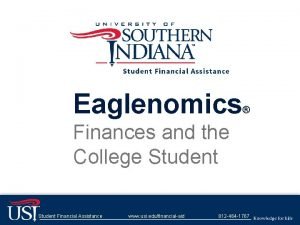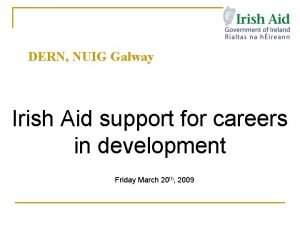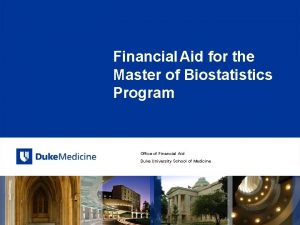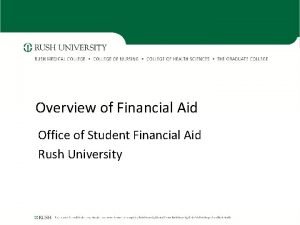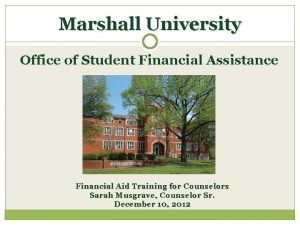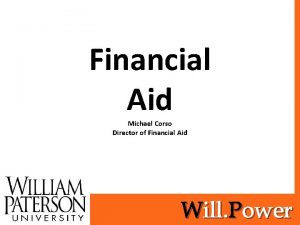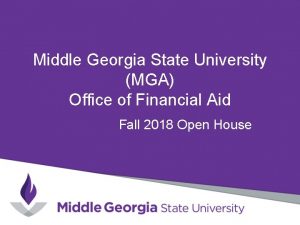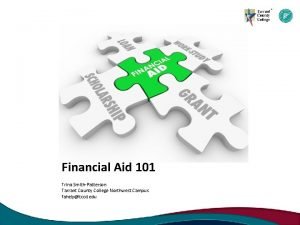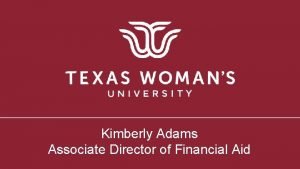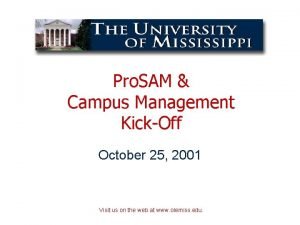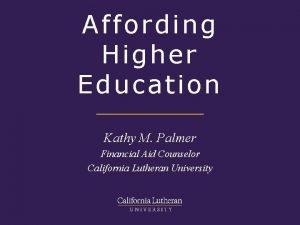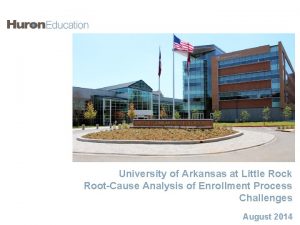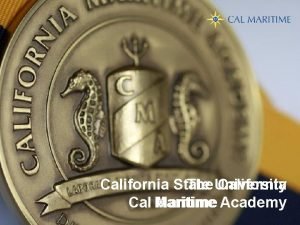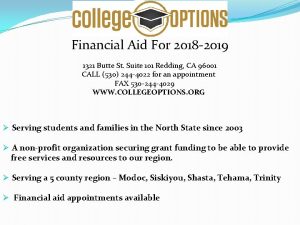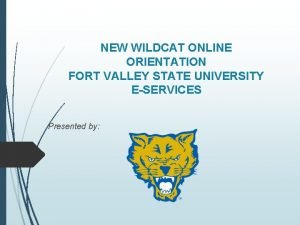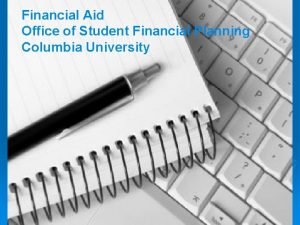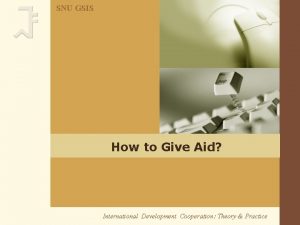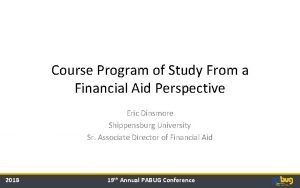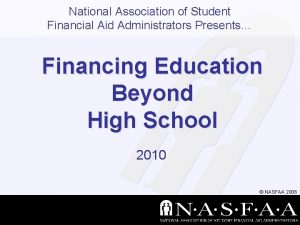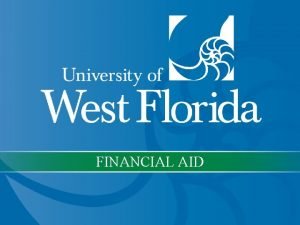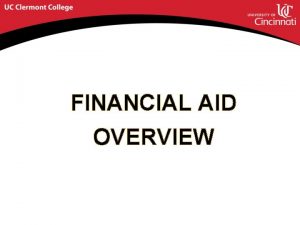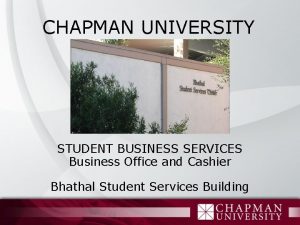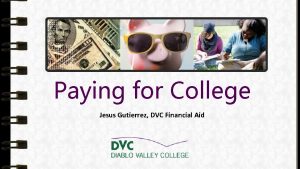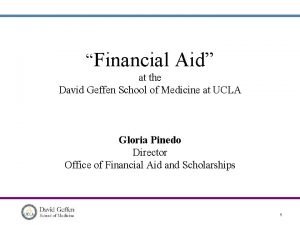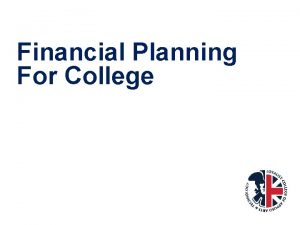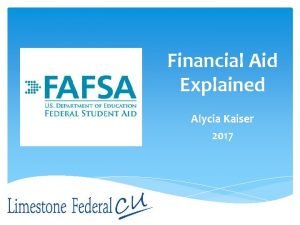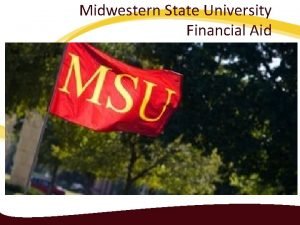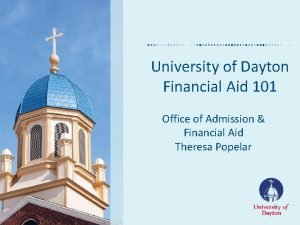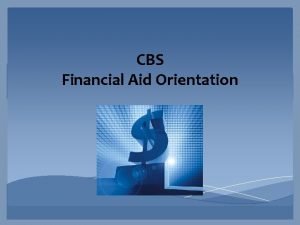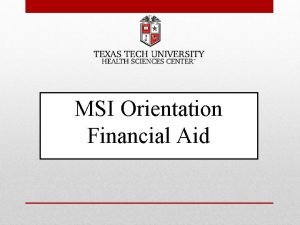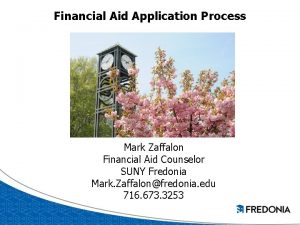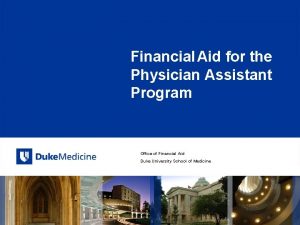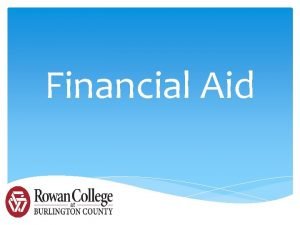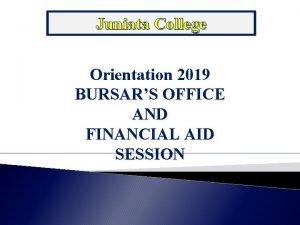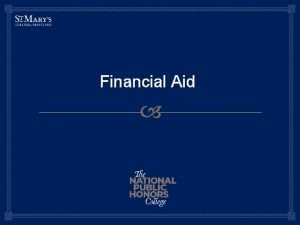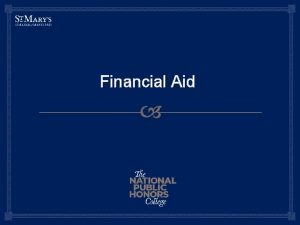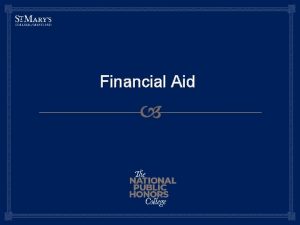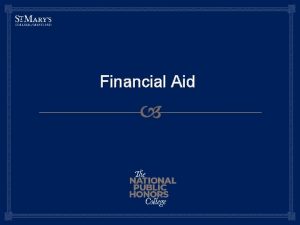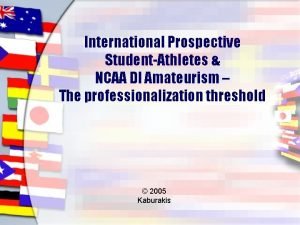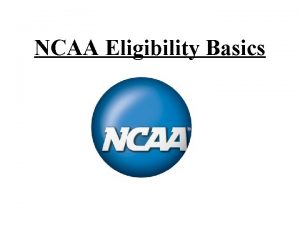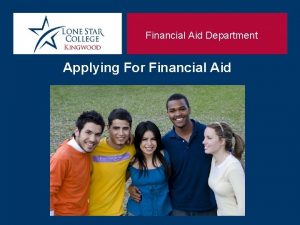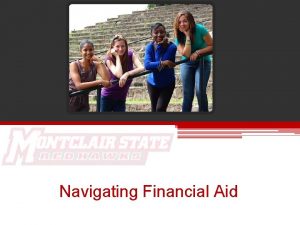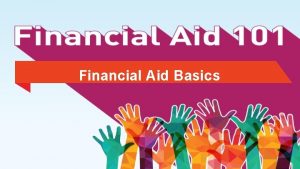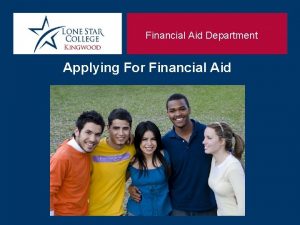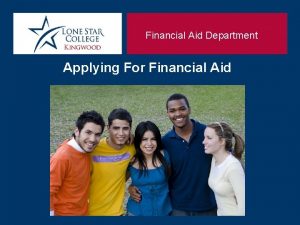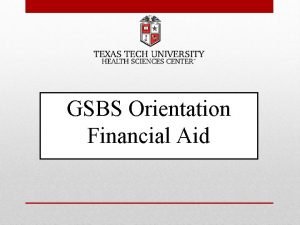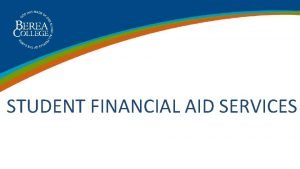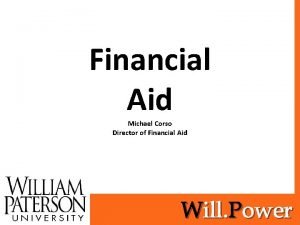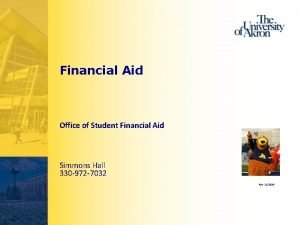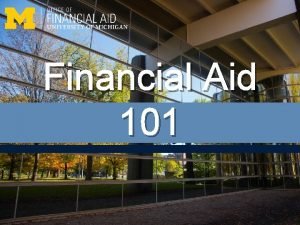Financial Aid for NCAA StudentAthletes Update on NCAA






















































- Slides: 54

Financial Aid for NCAA Student-Athletes: Update on NCAA Bylaw 15 Kris Richardson NCAA Academic and Membership Affairs

Overview • Impact of NCAA Division I Proposal No. 2011 -97. – Period of award. – Aid to former student-athletes. • New legislation. • Miscellaneous expense allowance. – Proposal No. 2011 -96. – Models under consideration. • Opportunities for involvement.

Impact of NCAA Proposal No. 2011 -97

Period of Award • Minimum - one academic year. • Maximum - student-athlete’s period of eligibility.

One-Year Awards • Aid must be disbursed in equal amounts. • Increase at any time for any reason. • No change to reduction/cancellation legislation.

One-Year Awards • Student may release institution from obligation to provide athletics aid. – Must be awarded institutional aid unrelated to athletics of equal or greater value than the signed award of athletically related aid.

Multiyear Awards • Cannot exceed period of eligibility. • Increase at any time for any reason. • During the period, no change to reduction/cancellation legislation. • Student cannot release institution from obligation to provide athletics aid.

Multiyear Awards - Renewals • Reduction occurs when: – Renewal period is for fewer years than the original agreement. • Unless the renewal includes the remaining years of the student-athlete's eligibility in all sports (e. g. , five-year period of eligibility).

Multiyear Awards - Renewals • Reduction occurs when: – Average amount of aid provided per year in the renewal is less than the average amount of aid provided per year in the original agreement. • Includes any increases during the period of the original award.

Case Study • Caitlin signs a three-year agreement with State University for tuition and books. – Valued at $6, 000 per year. – Full grant-in-aid is valued at $10, 000. – Agreement represents 0. 60 equivalency. Year Fall Spring Equivalency 2012 -13 $2, 600 + books 0. 60 2013 -14 $2, 600 + books $3, 600 + books 0. 70 2014 -15 $3, 600 + books 0. 80

Case Study • Coach comes to see you about Caitlin’s renewal. • Plans to renew her for two years at 0. 65 equivalency. • Is this a reduction?

Case Study • Reduction occurs if: – Renewal period is for fewer years than the original agreement, unless it is for the remainder of the eligibility period. • Original agreement was for three years. • Renewal is for two years. – But, renewal is for the remainder of her eligibility period.

Case Study • Reduction occurs if: – Average amount of aid provided per year in the renewal is less than the average amount of aid provided per year in the original agreement. • Original agreement represented 0. 60 equivalency. • Renewal represents 0. 65 equivalency.

Case Study • But, must include any increases during the period of the original award. – Renewal represents 0. 65 equivalency. – Average amount of aid provided per year. • (. 60 +. 70 +. 80) / 3 = 0. 70 equivalency. • This is a reduction and Caitlin must be notified of the opportunity for a hearing.

Aid to Former Student-Athletes

Eligibility of Student-Athletes for Institutional Financial Aid • Proposal No. 2011 -97. – May award institutional financial aid during any term in which a student-athlete was enrolled initially in a minimum full-time program of studies during the term if: • Undergraduate with eligibility remaining under five-year rule. or • Graduate student eligible under postbaccalaureate /graduate student legislation.

Aid to Former Student-Athletes • Proposal No. 2011 -97. – Eliminated the “five in six years” limit on receipt of unearned athletics aid. – Permits former student-athletes to receive unearned aid for any term in which they are enrolled. • Full time or part time.

Newly Adopted Legislation

Proposal Nos. M-2011 -7 and M-2012 -2 Books • If student enrolls for less than a full academic year and receives any portion of a book allowance, it is represented proportionately in the numerator. – $400 for semester schools. – $534 or $267 for quarter schools. • Remains $800 in the denominator.

Newly Adopted Legislation • Proposal No. 2011 -43. – Football Bowl Subdivision only. • Reduces limit of signees from 28 to 25. • Limit applies from December 1 through May 31. • Student who becomes a counter for the academic year during which signing occurs is not included in limit. – Effective August 1, 2012.

Newly Adopted Legislation • Proposal No. 2011 -74. – Summer athletics aid not required to be in proportion to academic year aid if: • Student-athlete has exhausted eligibility; and • Is enrolled in degree courses. – Not required to graduate at end of summer term. – Not required to be enrolled in all degree courses offered. – Effective Immediately.

Newly Adopted Legislation • Proposal No. 2011 -75. – In football, prospective student-athlete who receives athletically related financial aid during a summer term is an initial and overall counter for the next academic year. – Applies even if prospective student-athlete is a nonqualifier or does not enroll. – Effective Immediately.

Newly Adopted Legislation • Proposal No. 2011 -77. – Exception to baseball’s minimum equivalency requirement. • Final year of eligibility; and • Never received athletically related aid in baseball. – Effective August 1, 2012.

Miscellaneous Expense Allowance

Miscellaneous Expense Allowance • Proposal No. 2011 -96. – October 27, 2011: Legislation adopted. – November 9 -16, 2011: National Letter of Intent early signing period. – December 19, 2011: Legislation suspended. • Received more than 125 override requests. – December 21, 2011: Start of National Letter of Intent signing period for football midyear twoyear college transfers. – January 14: Legislation defeated.

Miscellaneous Expense Allowance • Financial aid agreements issued before December 20, 2011, could include a miscellaneous expense allowance. • No miscellaneous expense allowances for summer terms.

Miscellaneous Expense Allowance • Eligibility for miscellaneous expense allowance. – Specified in written financial aid agreement. and – Awarded athletically related and/or nonathletically related financial aid equal to the value of a full grant-in-aid.

Miscellaneous Expense Allowance • Miscellaneous expense allowance may include: – Additional athletically related institutional financial aid. or – Combination of athletically related and nonathletically related financial aid up to lesser of cost of attendance or $2, 000.

Miscellaneous Expense Allowance • Three models currently under consideration. – Miscellaneous expense allowance. – Unmet need grant. – Supplement NCAA Student Assistance Fund. • All would permit up to $2, 000.

Miscellaneous Expense Allowance • No vote on this initiative before August 2 meeting of NCAA Division I Board of Directors. • Legislation would not be effective before 2013 -14 academic year.

Miscellaneous Expense Allowance • Opportunity for working group to: – Obtain information from spring /summer meetings. – Conduct focus group meetings. – Evaluate practical and administrative burdens. – Ensure gender-equity issues are fully addressed.

Miscellaneous Expense Allowance Model 1: Miscellaneous Expense Allowance • Maintain current definition of a full grant-in-aid. • Maintain current regulations and exemptions concerning individual financial aid limits regarding cost of attendance.

Miscellaneous Expense Allowance Model 1: Miscellaneous Expense Allowance • Permit up to $2, 000 of “exempt aid, ” not to exceed cost of attendance, when all sources of aid countable toward individual limits are included for any student-athlete who receives a full or equivalency grant-in-aid. – May be provided to full and equivalency grant recipients. • Demonstrated financial need not required to qualify.

Miscellaneous Expense Allowance Model 1: Miscellaneous Expense Allowance • Alternative 1. – Limit miscellaneous expense allowance for an equivalency grant based on proportionality. – Example: • 0. 33 or less = $500 • 0. 67 -. 99 = $1, 500 0. 34 - 0. 66 = $1, 000 1. 0 = $2, 000.

Miscellaneous Expense Allowance Model 1: Miscellaneous Expense Allowance • Alternative 2. – Exempt Pell Grant from counting toward individual limit. – Would permit more Pell Grant recipients to receive the full $2, 000.

Miscellaneous Expense Allowance Model 2: Unmet Need Grant • Maintain existing definition of a full grant-inaid. • Maintain current regulations and exemptions concerning individual financial aid limits regarding cost of attendance.

Miscellaneous Expense Allowance Model 2: Unmet Need Grant • Permit up to $2, 000 based on “unmet need, ” not to exceed cost of attendance, when all sources of grant and gift aid countable toward individual limits are included for any studentathlete who receives a full or equivalency grantin-aid.

Miscellaneous Expense Allowance Model 2: Unmet Need Grant • Determining Unmet Need. – Student-athlete shall file a FAFSA. – If not eligible to file, shall follow institution’s uniform or institutional methodology to establish expected family contribution. • Unmet Need. – Equals cost of attendance – expected family contribution – grant-in-aid – other gift or grant aid. – Outside gift aid and exempt institutional aid that does not count toward cost of attendance is included when determining unmet need.

Miscellaneous Expense Allowance Model 2: Unmet Need Grant • Examples. • Cost of Attendance = $25, 000 and Full Grant-in. Aid = $19, 000. • Student-Athlete 1. Expected Family Contribution = $0. – Athletics Grant-in-Aid = $19, 000; – Pell Grant = $5, 500; – Other Grants = $0. – Unmet Need is $500. – Unmet Need Grant of up to $500 may be provided.

Miscellaneous Expense Allowance Model 2: Unmet Need Grant • Cost of Attendance = $25, 000 and Full Grant-in. Aid = $19, 000 • Student-Athlete 2. Expected Family Contribution = $10, 000 – Athletics Grant-in-Aid = $2, 000 – Pell Grant = $0 – Other Grants = $3, 000 – Unmet Need is $10, 000. – Unmet Need Grant of up to $2, 000 may be provided.

Miscellaneous Expense Allowance Model 2: Unmet Need Grant • Cost of Attendance = $25, 000 and Full Grant -in-Aid = $19, 000 • Student-Athlete 3. Expected Family Contribution = $20, 000 – Athletics Grant-in-Aid = $19, 000 – Pell Grant = $0 – Other Grants = $0 – Unmet Need is $0. – Unmet Need Grant not permissible.

Miscellaneous Expense Allowance Model 3: Institutional Supplement to NCAA Student-Athlete Opportunity Fund • Permit institutions to supplement NCAA Student. Athlete Opportunity Fund by up to the total of $2, 000 multiplied by total number of grant-in-aid awarded. – Example: • Head count awards = 130 • Equivalency awards = 80 • Permitted Student-Athlete Opportunity Fund supplement • (130+80)*$2, 000 = $420, 000.

Miscellaneous Expense Allowance Model 3: Institutional Supplement to Student-Athlete Opportunity Fund • Continue to prohibit use of Student-Athlete Opportunity Fund toward “countable” athletics aid, except summer school. • Continue to permit institutions to use Student. Athlete Opportunity Fund funds for direct benefits to student-athletes.

Miscellaneous Expense Allowance Model 3: Institutional Supplement to Student-Athlete Opportunity Fund • Permit use for up to a $2, 000 “Miscellaneous Expense Allowance, ” not to exceed cost of attendance, when combined with other sources of financial aid that count toward individual limits. – At discretion of institution and its conference. – May be provided any student-athlete.

Miscellaneous Expense Allowance Model 3: Institutional Supplement to Student-Athlete Opportunity Fund • New allocation of funds not restricted to miscellaneous expenses allowances. – May be used for other direct benefits to studentathletes as currently permitted.

Opportunities for Involvement

Opportunities for Involvement • Review of miscellaneous expense allowance models is underway. • Participate in the discussion. – Talk with president or chancellor. – Talk with faculty athletics representative. – Talk with athletics. • Provide feedback via ncaa. org.

Opportunities for Involvement • Review of Bylaw 15 begins this year. – Plan will be presented to cabinet in June. • Areas for review. – Phase I • Equivalency computation method; • Team maximum financial aid limitations (head count and equivalency, as well as number of grants-in-aid); and • Terms and conditions of awarding institutional financial aid.

Opportunities for Involvement • Areas for review. – Phase II • Role of recruited status on financial aid; • Period of award; • Summer financial aid; and • Retroactive financial aid.

Opportunities for Involvement • Surveys will be distributed. – Need feedback from financial aid officials. • Focus group and subgroup participation opportunities. • Information available on NCAA Working Group on Collegiate Model – Rules page at ncaa. org.

Opportunities for Involvement • Participation on NCAA Division I Awards, Benefits, Expenses and Financial Aid Cabinet. – Two seats for financial aid officers. • Private – Mike Scott, Texas Christian University. • Public – Brian Quisenberry, Virginia Military Institute. – Four-year terms. – Three in-person meetings per academic year.

Opportunities for Involvement • Participation on Awards, Benefits, Expenses and Financial Aid Cabinet. – Accepting nominations from private institutions. – Deadline is May 11. – Term begins in July.

Review • Impact of NCAA Proposal No. 2011 -97. – Period of award. – Aid to former student-athletes. • New legislation. • Miscellaneous expense allowance. – Proposal No. 2011 -96. – Models under consideration. • Opportunities for involvement.

Questions?
 Which is an alternative of log based recovery
Which is an alternative of log based recovery First aid merit badge first aid kit
First aid merit badge first aid kit Neasden and greenhill park medical centre
Neasden and greenhill park medical centre Usi financial aid office
Usi financial aid office Nuig financial aid
Nuig financial aid Linfield financial aid office
Linfield financial aid office Duke financial aid office
Duke financial aid office Rush financial aid office
Rush financial aid office Mustang guarantee program
Mustang guarantee program Southeastern leonet
Southeastern leonet Baylor scholarship calculator
Baylor scholarship calculator Financial aid office marshall university
Financial aid office marshall university Mvnu student accounts
Mvnu student accounts William paterson financial aid office
William paterson financial aid office Vanderbilt isfaa form
Vanderbilt isfaa form Mga bursar office
Mga bursar office Au access ebill
Au access ebill Tccd financial aid office
Tccd financial aid office Twu pay my bill
Twu pay my bill Prosam financial aid
Prosam financial aid Palmer financial aid
Palmer financial aid Ualr financial aid office
Ualr financial aid office Bursar's office university of louisville
Bursar's office university of louisville Cal maritime tuition
Cal maritime tuition Butte financial aid
Butte financial aid Fvsu book voucher
Fvsu book voucher Financial planning columbia
Financial planning columbia Snu financial aid
Snu financial aid Algonquin college financial aid office
Algonquin college financial aid office Roaenrl
Roaenrl National association of financial aid administrators
National association of financial aid administrators Uwf federal school code
Uwf federal school code Blaine kelley
Blaine kelley Fau financial aid email
Fau financial aid email Iup easypay
Iup easypay Chapman student business services
Chapman student business services Dvc federal school code
Dvc federal school code Sacramento city college lvn to rn
Sacramento city college lvn to rn Detroit mercy dental school tuition
Detroit mercy dental school tuition Financial aid csuci
Financial aid csuci Ucla dgsom financial aid
Ucla dgsom financial aid Loyalist college financial aid
Loyalist college financial aid Kaiser financial aid
Kaiser financial aid Msu texas financial aid
Msu texas financial aid Dayton financial aid
Dayton financial aid Cbs financial aid
Cbs financial aid Ttuhsc financial aid
Ttuhsc financial aid Fredonia financial aid office
Fredonia financial aid office Lori crooks duke
Lori crooks duke Troy financial aid office
Troy financial aid office Dmacc financial aid office
Dmacc financial aid office University of puget sound financial aid
University of puget sound financial aid Rcbc scholarships
Rcbc scholarships Financial aid card
Financial aid card Cashnet juniata
Cashnet juniata



